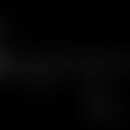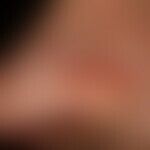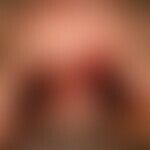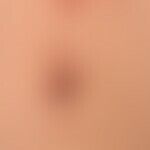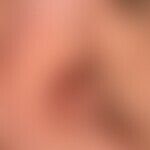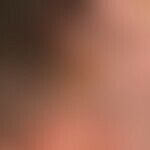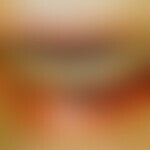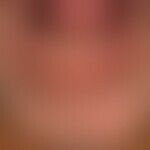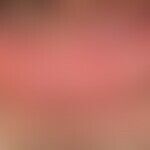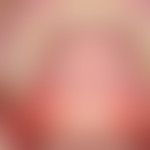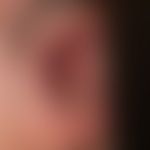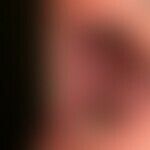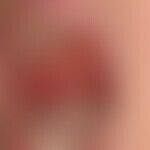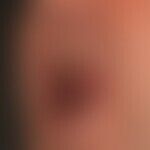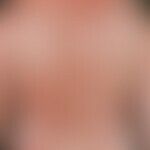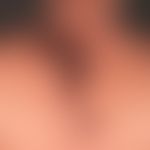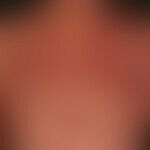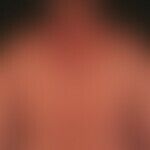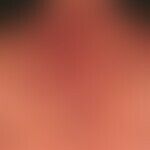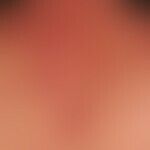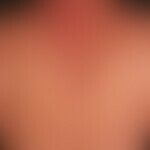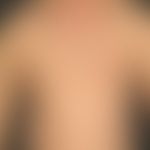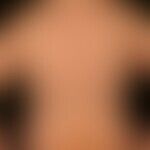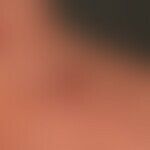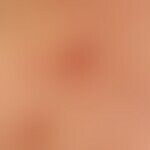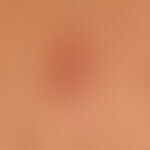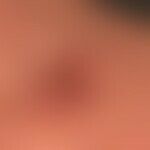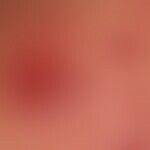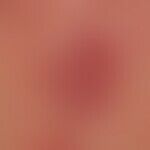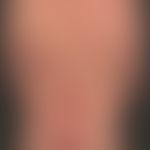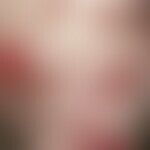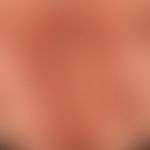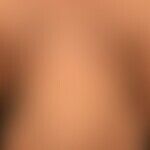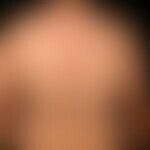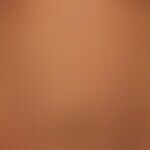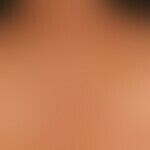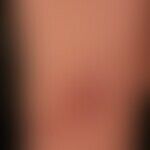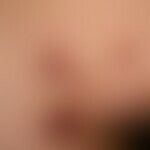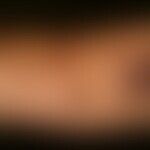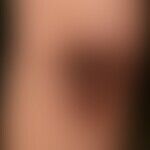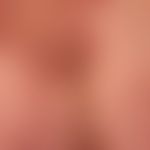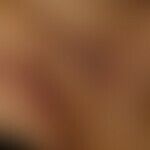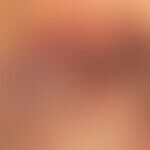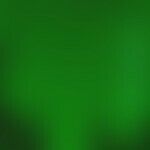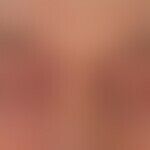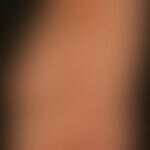HistoryThis section has been translated automatically.
DefinitionThis section has been translated automatically.
Chronic autoimmune disease associated with acantholytic blistering of the skin and/or mucous membranes, which may be severe and fatal without therapy. Pemphigus vulgaris is the most common variant of the pemphigus group.
Pemphigus vulgaris often progresses in two stages in an initially localized, later generalized form.
To be distinguished is:
- the mucosal dominant pemphigus vulgaris
- the mucocutaneous pemphigus vulgaris
You might also be interested in
Occurrence/EpidemiologyThis section has been translated automatically.
Incidence: 0.1-0.5/100,000 population/year worldwide; clustered in Ashkenazi Jews.
Incidences in detail:
- Germany: 0.15/100,000
- Switzerland and Finland: 0.06-0.076/100,000
- 0.8-1.0: Greece, Romania, Iran
- Jewish population: 1,6-3,2/100.000
- Mortality: 5-10% global
EtiopathogenesisThis section has been translated automatically.
According to the classification of Coombs and Gell, pemphigus vulgaris is a type II allergic reaction (cytotoxic reaction).
Formation of autoantibodies against desmoglein 3 (Dsg 3) or desmoglein 1 (Dsg 1-s.u. DSG1 gene). Desmogleins are adhesion molecules from the cadherin family and are expressed on the surface of keratinocytes, among others. Other autoantibodies (around 50 target antigens have been described to date), which are formed in pemphigus vulgaris, are directed against desmocollin, plakoglobin, pemphaxin (annexin 9),E-cadherin, desmocollins and the cholinergic receptor of keratinocytes (see cell contacts below). As the keratinizing epidermis expresses both Dsg 1 and Dsg 3, but the mucous membrane expresses almost only Dsg 3, immunoreactivity against Dsg 3 predominantly causes mucosal changes. In contrast, the integument is involved in the formation of antibodies against Dsg 1 and 3.
The binding of autoantibodies in the tissue is associated with an inflammatory reaction, which is linked to autoinflammatory mechanisms such as inflammasome activation and leukocyte recruitment as well as an adaptive immune response of antigen-specific T cells.
Drug induction after taking certain medications has been described for:
- Bucillamine
- Captopril(ACE inhibitor)
- Cephalexin(cephalosporin)
- chloroquine
- Ciprofloxacin
- Diclofenac
- D-penicillamine
- Enalapril(ACE inhibitor)
- furosemide
- indomethacin
- Levofloxacin
- Nifedipine
- phenacetin
- PUVA therapy
- rifampicin
- Sulfasalazine
- Terbinafine
- Immune checkpoint inhibitors
Drug-induced pemphigus vulgaris can be induced even after years of good tolerance to a drug.
External provocation: Triggering by burns, UV radiation, X-ray irradiation is possible.
ManifestationThis section has been translated automatically.
Depending on the population, there are different initial manifestations:
- In European countries, the age of first manifestation is 50-60 years.
- In non-European countries it is lower (30-50 years, average 43.4 years Daneeshpazhoo et al. 2012)
- The disease is less common in childhood and late adulthood.
LocalizationThis section has been translated automatically.
In the localized stage: oral cavity (cheeks, palate, gingiva), nasal cavity (bloody cold), pharynx, genital mucosa, urethra, conjunctiva. Umbilical region, especially intertriginous areas (genital and perianal area) and periungual area may be affected.
In the generalized stage, disseminated clinical picture with symmetrical infestation of the trunk, capillitium, axillae, groin region, extremities.
ClinicThis section has been translated automatically.
Pemphigus vulgaris usually manifests in two stages:
1. localized chronic erosive dermatitis and mucositis:
A chronic insidious onset, fluctuating between improvement and recurrence, is typical. Note: Blisters are often not seen at this localized stage; thus, the disease is usually not clinically evaluated as blistering.
Frequently (>50%!) first clinical manifestations in the oral cavity (erosive, painful stomatitis, fetor ex ore).
Skin involvement (>80%): localized pemphigus vulgaris is usually not clinically recognized as a blistering disease. It is diagnosed as pyoderma, weeping, and usually also as therapy-resistant pyoderma. Clinically, there are mostly large, crusted erosions on the trunk, cheeks, umbilical region, capillitium. Further manifestations are: red lips (clinically: erosive, crusty cheilitis), eyelids (clinically: weeping eczema), fingers (clinically: chronic, painful and therapy-resistant paronychia).
Further in decreasing frequency:
- Nasal mucosa: refractory, bloody secreting rhinitis.
- Pharynx: painful dysphagia (possibly combined with laryngitis: dysphagia, hoarseness).
- Conjunctiva: erosive and therapy-resistant conjunctivitis (cave: corneal ulcer)
- genital and anal mucosa: erosive vulvitis/balanitis and proctitis
In relevant oral mucosal infestation, weight loss is often an accompanying sign!.
2. generalized, chronic, erosive dermatitis and mucositis.
The generalized stage may occur suddenly. In this stage, in the absence of an inflammatory (local) preliminary stage, rapidly bursting clear, first tense, then flaccid, extremely fragile, rapidly bursting (the rupturability of the blister roof is the hallmark of intraepidermal pemphigus) large blisters occur, the bursting of which leave large areas of weeping erosion. These rapidly crust over.
Note: In pemphigus vulgaris, you have to look for blisters to find them!
Furthermore: Activity spurts lead to new erosion areas, while the old ones, already crusted, still persist. This results in a changeable clinical picture with large, weeping or encrusted erosions whose crumpled blister edges lie on the erosion surfaces like wet paper. They can be pushed off tangentially by light finger pressure (the diagnostically important Nikolski phenomenon is positive).
This resulted in the clinical leading symptoms of PV. These are not extensive blisters, but extensive, crusted erosions with lobular blister margins. Sometimes, weeping crusts that are difficult to detach impose exclusively.
In the phase of generalization, skin and mucous membrane changes (see above) occur together. The formation of painful erosions is possible on all mucous membranes close to the skin. The rare manifestation in the esophageal region can become an emergency situation!
Special forms: pemphigus herpetiformis, erythema anulare-like pemphigus, intertrigo-like pemphigus, pemphigus vegetans.
HistologyThis section has been translated automatically.
It is recommended to carefully remove a small intact bladder using a biopsy so that the bladder remains intact. If the removal of a complete bladder is not successful, a marginal biopsy is performed to detect the perilesional area of erosion (note: epidermis cannot float during preparation).
Tip: If the tissue appears very fragile, it is advisable to spread the biopsy on a small piece of firm, dry, absorbent paper and to place the paper with the specimen adhering to it in the 10% formalin solution. This fixes the material in its anatomically correct manner and is easier to prepare.
Further recommendation: It is not recommended to cut a bubble (histology and immunofluorescence), because the artifact when cutting often makes a histological evaluation significantly more difficult or impossible.
There are no preferences regarding the location of the tissue samples!
The histologist is asked to assess the bioptate by means of serial processing. HE diagnostics is sufficient.
In terms of results a superficial dermatitis with suprabasal, acantholytic continuity separation and blistering is found. In older blisters: neutrophil and eosinophil leucocytes. Electron microscopy: Desmolysis.
Direct ImmunofluorescenceThis section has been translated automatically.
The diagnosis of pemphigus vulgaris can be confirmed immunohistologically (this diagnosis is highly relevant!). A perilesional biopsy is important! The biopsy of a bladder can lead to a false positive (Ig and C3 are deposited non-specifically) or to a false negative result (Ig/C3 is degraded proteolytically, or the bladder roof does not appear at all for technical reasons). A preference for a certain body region is diagnostically not recommended.
The detection of IgG and mostly complement components (C3,C4,C1) in the intercellular space of the epidermis is diagnostic evidence.
Indirect immunofluorescenceThis section has been translated automatically.
Monkey esophagus is the most sensitive tissue for the detection of pemphigus antibody in serum. Sensitivities between 86% and 100% have been described.
Differential diagnosisThis section has been translated automatically.
Depending on the pattern of infestation, different clinical constellations and thus different DD result.
With initial and initially exclusive infestation of the oral mucosa:
- Erosive lichen planus: Lack of serologic evidence! Indirect: IF: Fibrinogen deposits and cytoid corpuscles. No IC fluorescence
- Erythema exsudativum multiforme: Lack of serologic evidence! Indirect: IF: negative in most cases. No IC fluorescence; the typical skin changes of EEM are usually present.
- Stomatitis aphthosa: Young age group or infants. Acute onset with severe general symptoms. IF: negative. DIF: no IC fluorescence
With localized skin infestation:
- Chronic pyoderma
- Microbial eczema
- M. Hailey-Hailey
In the stage of generalization:
- Microbial eczema
- Extensive pyoderma
- Subcorneal pustulosis (Sneddon-Wilkinson)
- Other blistering diseases
- M. Darier
- M. Grover
Complication(s)This section has been translated automatically.
The extensive erosions are an entry point for pathogens, which lead to secondary infections up to sepsis. Further danger of bronchopneumonia, cachexia.
During pregnancy: diaplacental transfer of IgG autoantibodies to the unborn → Occurrence of pemphigus in the newborn (Pemphigus neonatorum) → Healing of pemphigus in the newborn usually within weeks
General therapyThis section has been translated automatically.
Notice!
Check intravenous accesses regularly (high risk of contamination), change daily if necessary! General guidelines for severe, large-area pemphigus vulgaris:- Intensive care in appropriately equipped therapy units.
- Isolation of the patient.
- Aseptic protective clothing, mouth protection for medical and nursing staff.
- Wearing of gloves.
- Sufficient heat supply (exact temperature control).
- Sufficient moisture content of the room air.
- Use special bed for decubitus prophylaxis.
- Fluid balancing, if necessary bladder catheter.
- Documentation of the findings (expansion, severity on intensive care treatment sheets).
- Swabs of the wound surfaces every day (culture with resistance behaviour), danger of Pseudomonas colonisation.
- Storage on metal foil.
- Open blisters and remove the blister cover.
- In open and superinfected areas 1% sulfadiazine-silver cream (e.g. flammazine).
- Eye hygiene with disinfecting and astringent eye drops (e.g. Solan eye drops).
- Scheme with daily dosage: colloidal solution (1 ml/kg x affected KO), electrolyte solution (physiological saline solution 1 ml/kg x affected KO).
- When stabilized, transition to high-calorie liquid food (meritene), later diet with passed food; no spices, no fruit acids.
External therapyThis section has been translated automatically.
Symptomatic (non-steroidal) therapy, e.g. with mild antiseptics such as 0.5% clioquinol cream(e.g. R049, Linola-Sept). Alternatively, 2% clioquinol ointment. Open the blisters sterilely. Avoid secondary infections. If secondary infection is suspected, swab and antibiogram immediately.
Eyes: Regular checks. Antiseptic eye drops such as zinc sulfate eye drops R297.
Mucosal lesions (oral or genital mucosa):
- Local therapy with topical glucocorticoids, e.g. with 0.1% betamethasone mouth gel 031, is useful as a "first step" therapy.
- Alternative: Good experience also exists with clobetasol cream (e.g. Dermoxin cream applied to a gauze-wrapped mouth spatula and applied locally).
- Alternatively: Aqueous prednisolone solution (Rp.: Nystatin 100KUI/Lidocaine 0.1/Prednisolone 0.1/ aqua purificata ad 100.0/ S: Apply mild well tolerated cortisone containing solution 1-2x daily).
- Alternative: Ciclosporin A-containing paste 046 or a 0.03% tacrolimus suspension.
- Alternative: 1% pimecrolimus cream, which is better tolerated in the mucosal area than ciclosporin and tacrolimus (apply these externals to the lesion with a soft toothbrush or on a gauze-wrapped spatula and leave on as long as possible). Perform treatment 2-3 times a day.
- If the pain is severe, treatment with a gel containing lidocaine (e.g. Dynexan-Mundgel®) or a spray containing lidocaine (e.g. Sulagil Spray®) is recommended. The Krister solution according to NRF 7.14 (combination preparation with lidocaine, prednisolone and chamomile extracts) is also suitable.
- After the meal, accompanying antiseptic mouth rinse with e.g. Octenisept mouth rinse solution or Betaisodona mouth rinse and subsequently caring Dexpanthenol solution or Tormentillae astringent(R066 R255).
Internal therapyThis section has been translated automatically.
Remember! Pemphigus vulgaris often proves to be resistant to therapy!
The disease requires intensive immunosuppression with medication, which must be maintained in the long term (with staying power)! High-dose systemically applied glucocorticoids in combination with immunosuppressants ( azathioprine [e.g. Imurek®]) or mycophenolate mofetil or cyclophosphamide (Endoxan®) or ciclosporin A (Sandimmun®) or, more rarely, methotrexate (MTX®) (in order of preference according to survey results among clinical experts). Steroidal long-term therapy can be applied daily or alternately every 2nd day (evidence level IIA). The duration of "steroid-sparing" therapy with immunosuppressants (proven for azathioprine) is usually > 2 years, possibly for life. Close monitoring of laboratory values is essential! Watch out for opportunistic infections!
The following treatment recommendations include the level of evidence and degree of recommendation, where available:
-
Rituximab (moderate to severe forms): For moderate to severe forms of pemphigus vulgaris and pemphigus folicacea, rituximab in combination with systemic glucocorticoids is recommended in accordance with the guidelines. Rituximab (MabThera®, anti-CD20 AK. Therapeutic principle of B-cell depletion with drop in antibody level) Dosage: Rituximab: 375 mg/m2 KO on day 1 and 14(-21) i.v. Time to response of therapy approx. 7 weeks).
A multicenter study showed complete remission in 86% of patients after 3 months following a single infusion of Rituximab (dose: 375 mg/m2 KO i.v.). Alternatively, Rituximab can also be used as monotherapy as a "low-dose" regimen (dose: 500 mg i.v. on day 1 and day 14).
- Glucocorticoids (A; II) in combination with immunosuppressive agents such as rituximab or azathioprine: start with 2.0-4.0 mg/kg bw/day prednisone equivalent (e.g. Decortin H) and 1.5-2.5 mg/kg bw/day azathioprine (e.g. Imurek). As long-term therapy, treatment with glucocorticoid doses below the Cushing's dose should be aimed for (< 7-10 mg/day prednisone equivalent). Leave azathioprine dose unchanged for the first few months! With longer clinical freedom from symptoms (healing of the old blisters, no further recurrence of blisters), reduce the azathioprine. Complete remissions under glucocorticoid/azathioprine combination in 28-53% of patients (mortality rate: 4-7%).
- It is recommended to adjust the dose of azathioprine to the individual activity of thiopurine methyltransferase (TPMT)! Patients with a TPMT activity < 5U/ml should not receive azathioprine.
- Glucocorticoid pulse therapy (C; IV): In case of resistance to therapy after several weeks of therapy (about 10% of cases), we recommend glucocorticoid pulse therapy while leaving the azathioprine dose unchanged: 1 g prednisone equivalent (e.g. Solu Decortin H) as a short infusion on 3 consecutive days, then decreasing dosage(750/500/250 mg/day). Leave azathioprine at the above dosage.
-
Cyclophosphamide (B; III): If resistance to therapy persists, azathioprine can be replaced with cyclophosphamide (e.g. Endoxan). Oral cyclophosphamide dose: 1.0-2.0 mg/kg bw/day. Cyclophosphamide can also be administered as pulse therapy(500-1000 mg/every 2-4 weeks)
Note! When using cyclophosphamide, bladder protection agents such as Mesna (e.g. Uromitexan) are essential!
- Alternative: As an alternative to prednisolone/cyclophosphamide pulse therapy, dexamethasone can also be combined with cyclophosphamide (day 1: Fortecortin® mono 100 mg as a short infusion/cyclophosphamide 500 mg via perfusor over 2 hours, day 2: dexamethasone 100 mg i.v.; day 3: dexamethasone 100 mg i.v.). Repeat pulse regimen permanently after 4 weeks.
- Alternative: Ciclosporin A (C; I): Experience with systemically applied Ciclosporin A is positive. In case of resistance to therapy, the immunosuppressant can be used in combination with a glucocorticoid, dosage: 5.0-7.5 mg/kg bw/day p.o.
- Alternative: methotrexate (C; III): To be used as an alternative therapy (to AZ and cyclophosphamide) in combination with prednisolone. Dosage: 15 mg/week i.m. or i.v. Folic acid should be administered on the following day (analogous dose to MTX).
- Alternative: mycophenolate mofetil (A; IB): So far there are case reports and a positive, randomized, placebo-controlled study (n = 94 patients!). Use is justified in the case of contraindications or failure of other immunosuppressants. The combination of mycophenolate mofetil (2 g/day) and methylprednisolone (2 mg/kg bw) appears to achieve good clinical results according to a multicenter study.
- Rituximab can be used as an alternative and steroid-sparing treatment. Opportunistic side effects (HSV, COVID, cytomegalovirus infections) including a higher risk of pneumococcal infections (penumococcal vaccination is recommended) must be taken into account (Chen DM et al. 2020; Frampton JE 2020).
- Alternative: IVIG (B; III): Good experience with high-dose i.v. immunoglobulin therapy (e.g. Intratect®). Usually carried out as monotherapy in studies. Dosage: 2.0 g/kg bw spread over 3 days, monthly therapy cycles. Caution! High therapy costs! Combinations with glucocorticoids are usually necessary. Alternative combination of Rituximab and IVIG: The combination therapy showed good clinical effects in a study in 9/11 patients after a total of 6 Rituximab infusions.
- Alternative: Plasmapheresis (C; I) (or immunoadsorption): In case of resistance to other treatments, initially as additional therapy with cycles every 14 days. The aim of the treatment is the prompt reduction of antibodies in the serum. However, a study with 19 patients showed no benefit in treated patients compared to a control group. Only indicated as a treatment modality if any other immunosuppressive therapy appears contraindicated. More recent studies appear to show a high level of effectiveness in terms of rapid clinical remission, but without a permanent cure. In small studies, success was achieved with the combination therapy immunoadsorption (3 times) and subsequent stabilizing therapy with rituximab (see below).
Recurrence and/or resistance to the previously listed therapy regimes: In the case of pronounced recurrence of skin or mucous membrane changes, high immunosuppression is again necessary initially (glucocorticoid pulse therapy)! In the case of minor recurrences (few erosions), immunosuppressive therapy should not necessarily be increased: first try local glucocorticoid therapy, potent glucocorticoids such as 0.1% mometasone (e.g. Ecural® ointment).
Progression/forecastThis section has been translated automatically.
Different course. Without therapy death mostly in 1 to 3 years. Physical decay due to aggravation of food intake.
Persistent high levels of desmoglein1 have (in contrast to desmoglein3 levels) a positive predictive value for skin recurrence.
TablesThis section has been translated automatically.
Step therapy for severe pemphigus vulgaris
Stage |
Therapy regime |
Stage I |
Glucocorticoids in combination with azathioprine: start with prednisone equivalent 2.0-4.0 mg/kg bw/day and azathioprine 1.5-2.0 mg/kg bw/day. |
Stage II |
Glucocorticoid pulse therapy: prednisone equivalent 1 g as a short infusion on 3 consecutive days. Leave azathioprine dose unchanged. If necessary, simultaneous plasmapheresis (cycles at 14-day intervals). |
Stage III |
Cyclophosphamide (instead of azathioprine) 1.0-2.0 mg/kg bw/day (also as pulse therapy; 500-1000 mg/month). |
Alternatively: Ciclosporin. | |
Stage IV |
Ciclosporin in combination with glucocorticoids (5.0-7.5 mg/kg bw/day p.o.). |
Experimental |
Immunoglobulins in high doses i.v. in combination with immunosuppressive therapy (glucocorticoids or methotrexate). |
Why is rituximab not listed here?
Diet/life habitsThis section has been translated automatically.
Note(s)This section has been translated automatically.
Associations with myasthenia gravis, thymomas, lupus erythematosus, lymphomas and carcinomas are present in varying percentages.
Patients with thymoma are associated with pemphigus vulgaris in 30% (!).
Documentation of the spread of the disease can be done by clinical records using the Autoimmune Skin Disorder Intensity Score (ABSIS) and the Pemphigus Disease Area Index (PDAI) (Boulard 2016)
LiteratureThis section has been translated automatically.
- Ahmed AR et al. (2007) Treatment of pemphigus vulgaris with rituximab and intravenous immune globulin. N Engl J Med 355: 1772-1779
- Alpsoy E et al. (2015) Geographic variations in epidemiology of two autoimmune bullous diseases: pemphigus and bullous pemphigoid. Arch Dermatol Res 307:291-298
- Altmeyer P et al (1999) High-dose intravenous immunoglobulin (IVIG) therapy for refractory ANCA-negative necrotizing vasculitis. Dermatology 50: 853-858
- Anhalt GJ et al (1990) Paraneoplastic pemphigus. An autoimmune mucocutaneous disease associated with neoplasia. New Eng J Med 323: 1729-1735
- Arin MJ et al. (2005) Anti-CD20 monoclonal antibody (rituximab) in the treatment of pemphigus. Br J Dermatol 153: 620-625
- Boulard C et al.(2016) Calculation of cut-off values based on the Autoimmune Bullous Skin Disorder Intensity Score (ABSIS) and Pemphigus Disease Area Index (PDAI) pemphigus scoring systems for defining moderate, significant and extensive types of pemphigus. Br J Dermatol 175:142-149.
- Campo-Voegeli A et al. (2002) Neonatal pemphigus vulgaris with extensive mucocutaneous lesions from a mother with oral pemphigus vulgaris. Br J Dermatol 147: 801-805
- Chaidemenos G et al. (2007) An alternate-day corticosteroid regim for pemphigus vulgaris. A 13-year prospective study. JEADV 21: 1386-1391
- Chams-Davatchi C et al. (2012) Randomized double blind trial of prednisolone and azathioprine, vs. prednisolone and placebo, in the treatment of pemphigus vulgaris. J Eur Acad Dermatol Venereol 27: 1285-1292
- Chen DM et al. (2020) Rituximab is an effective treatment in patients with pemphigus vulgaris and demonstrates a steroid-sparing effect. Br J Dermatol 182:1111-1119.
- Cooper HL et al. (2003) Treatment of resistant pemphigus vulgaris with an anti-CD20 monoclonal antibody (rituximab). Clin Exp Dermatol 28: 366-368
- Daneshpazhooh M et al. (2012) Spectrum of autoimmune bullous diseases in Iran: a 10-year review. Int J Dermatol 51:35-341
- Eming R et al. (2015) S2k guidelines for the treatment of pemphigus vulgaris/foliaceus and bullous pemphigoid. JDDG 13: 833-844.
- Frampton JE (2020) Rituximab: A Review in Pemphigus Vulgaris. Am J Clin Dermatol 21:149-156.
- Günther C (2016) Mucosal involvement in blistering diseases. Dermatologist 67: 774-779
- Harman KE (2003) Guidelines for the management of pemphigus vulgaris. Br J Dermatol 249: 926-937
- Hertel M et al. (2007) Rituximab (anti-CD20 monoclonal antibody)-ultimate or first choice in pemphigus? Dermatology 214: 275-277
- Horvath B et al. (2012) Low-dose rituximab in pemphigus. Br J DErmatol 166: 405-412
- Joly P (2007) A single cycle of retuximab for the treatment of severe pemphigus. N Engl J Med 357:545-552
- Kim SC et al (2001) Pemphigus vulgaris with autoantibodies to desmoplakin. Br J Dermatol 145: 838-840
Krammer S et al. (2019) Recurrence of Pemphigus Vulgaris Under Nivolumab Therapy. Front Med (Lausanne) 6:262.
- Schmidt E et al. (2015)S2k guideline for the diagnosis of pemphigus vulgaris/foliaceus and bullous pemphigoid. JDDG 13: 713-727
- Ljubojevic S et al. (2002) Pemphigus vulgaris: a review of treatment over a 19-year period. J Eur Acad Dermatol Venereol 16: 599-603
- Magnolo N et al (2014) Dermatosis-mimicking cutaneous drug reactions. Dermatologist 65:424-429
- Mimouni D et al. (2003) Differences and similarities among expert opinions on the diagnosis and treatment of pemphigus vulgaris. J Am Acad Dermatol 49: 1059-1062
- Schlesinger N et al. (2002) Nail involvement in pemphigus vulgaris. Br J Dermatol 146: 836-839
- Shimanovich I et al. (2006) Improved protocol for treatment of pemphigus vulgaris with protein A immunoadsorption. Clin Exp Dermatol 31: 768-774
- Schmidt E et al. (2015) S2k guideline for the diagnosis of pemphigus vulgaris/foliaceus and bullous pemphigoid. JDDG 13: 713-726
- Turner MS et al. (2000) The use of plasmapheresis and immunosuppression in the treatment of pemphigus vulgaris. J Am Acad Dermatol 43: 1058-1064
- Vecchietti G (2003) Topical tacrolimus for relapsing erosive stomatitis in paraneoplastic pemphigus. Br J Dermatol 148: 833-834
- Wichmann JE (1793) Pemphigus. In: Wichmann JE (ed) Ideen zur Diagnostik, vol. 1, Verlag der Helwing'schen Hof-Buchhandlung, Hannover, pp. 103-230
- Venugopal SS et al (2012) Diagnosis and clinical features of pemphigus vulgaris. Immunol Allergy Clin North Am 32:233-243
- Yoo SS et al. (2003) Disseminated cellulitic cryptococcosis in the setting of prednisone monotherapy for pemphigus vulgaris. J Dermatol 30: 405-410
Incoming links (53)
Acantholysis; Autoimmune dermatoses, bullous; Balanitis symptomatica; Cadherine; CD classification; Ciclosporin a; Clioquinol cream 0.5-2% (o/w); Conjunctivitis; Conjunctivitis in pemphigus; Daclizumab; ... Show allOutgoing links (58)
Ace inhibitors; Adhesion molecules; Antiseptic; Autoantibodies; Azathioprine; Cadherine; Carcinoma of the skin (overview); Cell contacts; Cephalosporins; Chamomile; ... Show allDisclaimer
Please ask your physician for a reliable diagnosis. This website is only meant as a reference.
Images (56)
Articlecontent
- History
- Definition
- Occurrence/Epidemiology
- Etiopathogenesis
- Manifestation
- Localization
- Clinic
- Histology
- Direct Immunofluorescence
- Indirect immunofluorescence
- Differential diagnosis
- Complication(s)
- General therapy
- External therapy
- Internal therapy
- Progression/forecast
- Tables
- Diet/life habits
- Note(s)
- Literature
- References
- Authors
